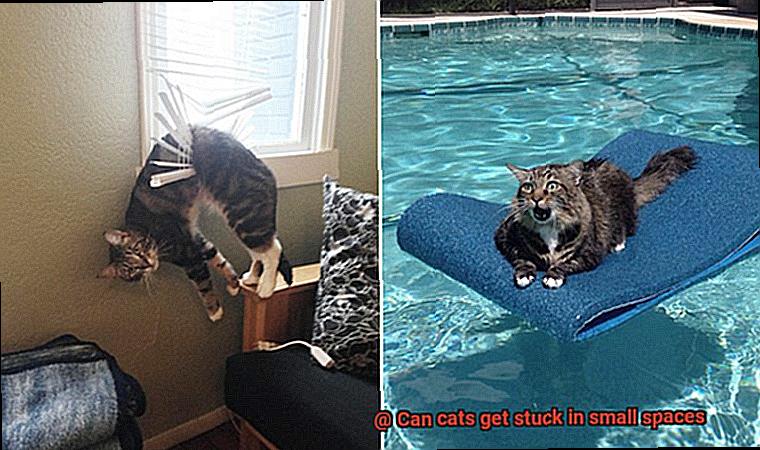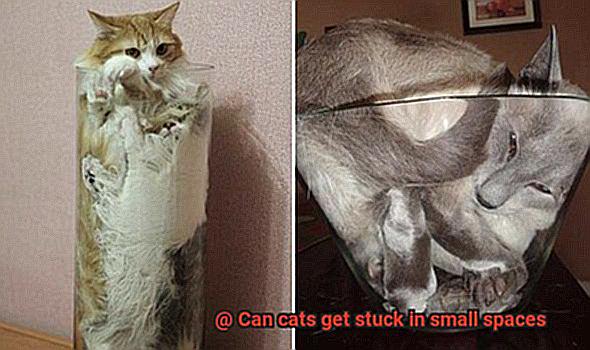As a cat lover, you’ve likely witnessed your feline friend contorting themselves into tight spaces that seem impossible to fit into. It’s impressive how agile and flexible they can be. But what happens if they get stuck? Can cats actually get trapped in small spaces? Unfortunately, the answer is yes.
Cats are naturally curious creatures and love to explore their surroundings. However, sometimes their curiosity can lead them astray and into dangerous situations. Despite their remarkable flexibility, there are times when they simply cannot wiggle out of a tight spot.
In this blog post, we’ll dive into the reality of cats getting stuck in small spaces. We’ll explore the types of spaces that cats typically find themselves trapped in and provide tips on how you can prevent these incidents from happening. We’ll also discuss the potential health risks associated with cats being stuck in confined areas for prolonged periods.
Furthermore, we’ll equip you with practical advice on what to do if you discover your cat has become trapped in a small space. Whether you’re a seasoned cat owner or simply an admirer of these fascinating creatures, keep reading to discover more about the scary reality of cats getting stuck in small spaces.
Common Places Where Cats May Get Stuck
Cats are natural explorers, but their curiosity can sometimes lead them into sticky situations. As a cat owner, it’s important to be aware of the common places where cats may get stuck to keep your furry friend safe and healthy.
Household Appliances
Household appliances like washing machines, dryers, and dishwashers can be a trap for curious cats. The warmth and vibration of these machines may lure your feline friend inside, but if they get trapped and the machine is turned on, it could lead to suffocation. Always check your appliances before turning them on, and keep them closed when not in use.
Small Spaces
Cats are notorious for squeezing into small spaces, but they may get stuck if they can’t find their way out. Furniture gaps and wall openings are common culprits for trapping cats. These spaces can cause serious injury to your pet if they struggle to free themselves. Use childproof locks or barriers to block off any small gaps or openings in your home.
Trees and High Places
Cats love to climb trees and explore high places, but sometimes they can’t find their way back down. If you notice your cat stuck in a tree, try coaxing them down with treats or toys. If this doesn’t work, contact your local animal control for assistance.
Small Spaces Outside
Cats may also get stuck in small spaces outside your home, such as drains or sewers. These spaces can be extremely dangerous as they can lead to serious injury or even death. Keep an eye on your cat when they are outside and ensure that any open drains or sewers are covered.
The Risks Associated With Cats Getting Stuck in Small Spaces
While it’s entertaining to watch them wiggle their way into small corners and crevices around the house, it’s important for pet owners to understand the risks associated with this behavior.
Firstly, cats can easily injure themselves while trying to escape from tight spaces. The process of squeezing into a small space can cause scratches and cuts from sharp edges. Additionally, if the space is too small, they may get stuck in a position that causes discomfort or pain. This can lead to serious injuries, which may require medical attention.
The danger of suffocation is also a significant risk associated with cats getting stuck in small spaces. If a cat becomes trapped in a confined space with limited airflow, they may suffocate over time. This is particularly dangerous if the space is airtight or if the cat is unable to move around freely. It’s crucial to be mindful of the spaces your cat has access to and monitor them closely.

Furthermore, being trapped in a confined space can cause psychological distress for cats, leading to behavioral problems such as aggression or destructive behavior. Your furry friend may also develop fear or aversion to certain areas of the house after getting stuck in them. To prevent this, make sure your cat has ample space to explore and play in.
To keep your cat safe from these risks, it’s important to create an environment that is conducive to their natural curiosity while also ensuring their safety. Some tips include keeping small spaces closed off or inaccessible, supervising your cat while they explore new areas, and providing plenty of toys and play areas for them to enjoy.
Signs That a Cat Is Trapped in a Small Space
As a responsible cat owner, it’s important to know the signs that your feline friend may be trapped in a small space.
One of the most obvious signs is excessive meowing or crying. If your usually quiet cat suddenly starts making distressed noises, it could be a sign that they’re stuck in a tight spot and can’t get out.
Another telltale sign is scratching or clawing at walls or furniture. Cats are equipped with sharp claws and will often try to claw their way out of a confined space if they can’t escape.
If your cat suddenly stops using their litter box and starts urinating or defecating in unusual places, it could be because they’re trapped somewhere nearby and can’t reach their usual spot.
In addition, cats who are trapped for an extended period of time may show a lack of appetite or water intake. This is a serious concern as dehydration can be life-threatening for cats.
Lastly, trapped cats may become scared and hide in unusual places or avoid human interaction altogether. If your once sociable cat suddenly becomes distant or starts hiding more than usual, it could be a sign that they’re stuck somewhere.
While not all cats will exhibit all of these signs if they become trapped in a small space, it’s important to keep an eye out for any unusual behavior and conduct a thorough search of your home if you suspect that your cat may be trapped.
Preventative Measures to Help Keep Cats Out of Tight Spaces
While this trait is undoubtedly endearing, it can be potentially dangerous, especially when it leads to them getting stuck in tight spaces. Fortunately, there are several preventative measures you can take to keep your cat safe and secure.
Firstly, provide enough space and entertainment for your cat to play and explore. By giving them interactive toys, scratching posts, and cat trees, they are less likely to investigate tight spaces. A bored cat is a curious cat, so keeping them entertained can help prevent them from seeking out hidden corners.

Supervising your cat’s playtime is also crucial. Keep an eye on their behavior and redirect their attention if they get too close to a small space or crevice. Remember that cats are agile creatures and can easily slip into even the tiniest of gaps, so it’s essential to be vigilant.
Sealing off potential entry points is another effective way to prevent your cat from getting into tight spaces. Cover open vents or gaps in walls or furniture that your cat may try to squeeze through. You can use baby gates or pet barriers to block off areas that you don’t want them to access.
Training your cat is also a great way to prevent them from getting stuck in tight spaces. Teaching them specific commands such as “come” or “stay” can help keep them out of trouble. Training your cat also improves their overall behavior and makes them easier to handle in different situations.
If you do suspect that your cat is stuck in a small space, remain calm, and avoid pulling or pushing them out as this may cause injury. Instead, try using treats or toys to coax them out gently. If this doesn’t work, seek professional help from a veterinarian or animal rescue service.
How to Safely Rescue a Cat Who Is Stuck in a Small Space

Cats are known for their insatiable curiosity, but sometimes that curiosity can get them into trouble. If your feline friend finds themselves stuck in a small space, it’s important to approach the situation with caution and care. Here are five steps to safely rescue your cat:
Assess the Situation
Before attempting a rescue, assess the situation and determine if it’s safe to do so. Take note of the size and location of the space and any potential hazards that could make the rescue more difficult.
Stay Calm
It’s essential to remain calm and avoid startling the cat. Loud noises or sudden movements can cause them to become more frightened and retreat further into their hiding spot.
Coax Them Out
If it’s safe to do so, try coaxing the cat out with food or toys. Be patient, as it may take some time for them to feel comfortable enough to come out.
Use Specialized Equipment
If coaxing doesn’t work, consider using a humane trap or other specialized equipment designed for animal rescue. However, be sure to avoid causing any harm or stress to the cat during this process.
Avoid Using Force
It’s crucial to avoid using force or causing any unnecessary harm during the rescue process. If you’re unsure of what steps to take, contacting a professional animal rescue organization or veterinarian for assistance can help ensure a safe and successful outcome.
Aftercare for a Cat Who Has Been Rescued From a Tight Spot
If you’ve recently rescued your cat from a tight spot, kudos to you. Your quick actions ensured your feline friend’s safety. However, your work is not yet done. Aftercare is crucial to ensuring your cat fully recovers and doesn’t develop any long-term health complications.
Firstly, take your cat to the vet for a thorough checkup. Even if your cat appears unharmed, a vet’s expert eye can catch underlying health issues that may not be immediately apparent. Depending on the severity of the situation, your vet may prescribe medication or recommend a specific diet to aid in recovery. It’s essential to follow their instructions and administer any medication as prescribed.
Providing a quiet and safe environment for your cat is equally important. Keep them away from potential hazards that could cause further harm, such as other pets or sharp objects. If your cat requires physical therapy or rehabilitation, work closely with your vet to develop a plan tailored specifically to their needs. This could include exercises or massages to improve blood flow and muscle tone.
Lastly, keep a close eye on your cat during the aftercare period. Look out for any signs of discomfort or concerning symptoms, such as difficulty breathing, loss of appetite, or lethargy. Don’t hesitate to contact your vet if anything seems amiss.
Remember, aftercare takes patience, attention to detail, and a commitment to providing the best possible care for your furry friend. With proper aftercare, most cats can make a full recovery and return to their happy and healthy selves in no time. In summary, here are some key steps to follow for aftercare:
Tips for Keeping Your Cat Safe From Getting Stuck in Small Spaces
Their inquisitive nature can often lead them into dangerous situations, such as getting stuck in small spaces. As a responsible pet owner, it’s important to take measures to ensure your feline friend’s safety and prevent them from getting trapped in tight spots. Here are some practical steps you can take:
Cat-proof your home
The first step to keeping your cat safe is to make sure that your home is cat-proofed. This means identifying potential hazards such as loose wires, open cabinets, or other areas where your cat could get stuck. By removing these hazards, you can create a safe environment for your cat to explore.
Limit access to certain areas
If your home has areas that are too small or risky for your cat to explore, use baby gates or other barriers to block them off. This will prevent your cat from getting stuck and help keep them safe.
Provide plenty of entertainment
To reduce the likelihood of your cat venturing into dangerous areas, provide them with plenty of toys, scratching posts, and other items that will keep them entertained and engaged. This will also help keep them mentally stimulated and happy.
Supervise your cat
When your cat is exploring new areas or playing in the house, keep a close eye on them. If you notice them trying to crawl into small spaces or climb onto high surfaces, intervene and redirect their attention elsewhere. By supervising your cat, you can prevent accidents before they happen.

Make essential items accessible
Your cat needs easy access to their food, water, and litter box. These essential items should be placed in an area where your cat can easily reach them without having to navigate through small spaces. This will also ensure that your cat stays healthy and comfortable.
Act quickly if your cat gets stuck
If you notice that your cat has become trapped in a small space, act quickly but calmly. Don’t try to force them out as this can cause serious injury. Instead, try to coax them out with treats or toys, or gently lift them out of the space if possible. If you’re unable to remove your cat from the space yourself, seek help from a veterinarian or animal rescue organization.
Conclusion
As a feline enthusiast, it’s crucial to recognize that cats are prone to getting stuck in tight spaces. Despite their natural curiosity and nimbleness, they can easily become trapped in hazardous situations.
Throughout this blog post, we’ve delved into the common areas where cats may find themselves stuck, the dangers associated with being confined in small spaces, indicators that your cat is trapped, measures you can take to prevent such incidents from occurring, how to safely extricate a cat from a tight spot, and follow-up care for rescued cats.
By implementing these suggestions and remaining vigilant about potential risks in your home, you can establish a secure environment for your furry companion to explore without fear of harm. Keep an eye on your cat during playtime and provide ample stimulation to keep them mentally engaged and contented.
If you suspect that your cat is caught in a cramped space, stay calm and try luring them out with treats or toys. If this approach fails, seek assistance from a veterinarian or animal rescue organization.
Once you’ve liberated your kitty from their predicament, ensure they receive a comprehensive medical examination and offer them a tranquil setting for recuperation. With proper attention and care, most cats can make a full recovery and resume their joyful existence without delay.
In conclusion, while cats’ agility makes them exceptional adventurers, it also exposes them to danger if not monitored carefully.







